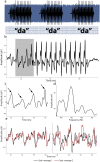Auditory Processing in Noise: A Preschool Biomarker for Literacy
- PMID: 26172057
- PMCID: PMC4501760
- DOI: 10.1371/journal.pbio.1002196
Auditory Processing in Noise: A Preschool Biomarker for Literacy
Abstract
Learning to read is a fundamental developmental milestone, and achieving reading competency has lifelong consequences. Although literacy development proceeds smoothly for many children, a subset struggle with this learning process, creating a need to identify reliable biomarkers of a child's future literacy that could facilitate early diagnosis and access to crucial early interventions. Neural markers of reading skills have been identified in school-aged children and adults; many pertain to the precision of information processing in noise, but it is unknown whether these markers are present in pre-reading children. Here, in a series of experiments in 112 children (ages 3-14 y), we show brain-behavior relationships between the integrity of the neural coding of speech in noise and phonology. We harness these findings into a predictive model of preliteracy, revealing that a 30-min neurophysiological assessment predicts performance on multiple pre-reading tests and, one year later, predicts preschoolers' performance across multiple domains of emergent literacy. This same neural coding model predicts literacy and diagnosis of a learning disability in school-aged children. These findings offer new insight into the biological constraints on preliteracy during early childhood, suggesting that neural processing of consonants in noise is fundamental for language and reading development. Pragmatically, these findings open doors to early identification of children at risk for language learning problems; this early identification may in turn facilitate access to early interventions that could prevent a life spent struggling to read.
Conflict of interest statement
The authors have declared that no competing interests exist.
Figures



References
-
- Tallal P. Auditory temporal perception, phonics, and reading disabilities in children. Brain Lang. 1980;9: 182–198. - PubMed
Publication types
MeSH terms
Substances
Grants and funding
LinkOut - more resources
Full Text Sources
Other Literature Sources
Medical

